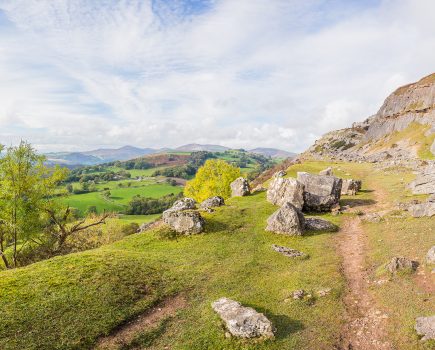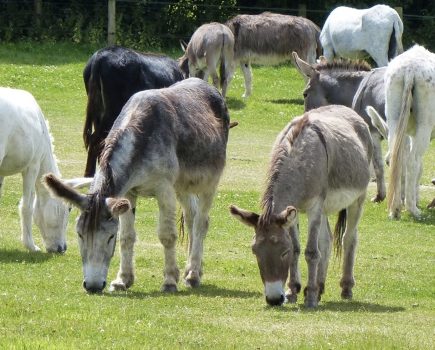Dr Sue Armstrong -Brown, the RSPB’s head of countryside policy, talks about how smallholders can help wild birds.
Dr Sue Armstrong -Brown, the RSPB’s head of countryside policy, talks about how smallholders can help wild birds.
I learned a new fact last week. Smallholders occupy around 900,000 ha of land, if you count holdings of less than 20 hectares as smallholdings. Quite an impressive area – especially when I reflected that the RSPB’s reserves cover around 150,000 ha. If the RSPB’s reserves are equivalent to an area the size of Bedfordshire, smallholdings taken in totality amount to an area the size of Cornwall, Norfolk and Suffolk combined.At the RSPB, we’re proud that our reserves provide habitat and shelter for a range of very special wildlife, from golden eagles to rare wood-boring wasps. No-one would expect a smallholding to be run like a nature reserve, but I found myself thinking that these areas could do an equally important job, and one which can’t be done on nature reserves alone. Farmland birds, such as yellowhammers and skylarks, are characteristically birds of the wider countryside, and these species are increasingly finding the modern farmed landscape a tough place to survive. If smallholders decided to make sure that their holdings were farmland bird-friendly, we would have a countryside peppered with havens for wild birds.
Dramatic declineOver the past 35 years, the UK has witnessed a dramatic decline in its farmland bird populations. Taken as a group, the 19 species that make up the Government’s Farmland Bird Index have fallen by 40 per cent since 1970. This figure masks much steeper declines in individual species, with grey partridge and corn bunting populations down by nearly 90 per cent, and skylark and lapwing populations halving. More generalist birds, such as greenfinches and woodpigeons, are doing well.The declines are a sadly unintended consequence of the intensification of farming practices over the past four decades. Across large areas, winter wheat has replaced spring wheat, silage has replaced hay and mixed farms are giving way to more efficient monoculture and block cropping. Of course, we are grateful for the abundance of food that has resulted – but the environmental costs have been high. In recent years, great strides have been made in recognising the plight of birds, and other wildlife, in the countryside. Successive Common Agricultural Policy (CAP) reforms have severed the link between farm support and production, removing a major incentive to overproduce. Agri-environment schemes have been developed and, in England, where funding is less restricted than other parts of the UK, there is impressive take-up, with almost 60% of farms now under some type of agreement. We have worked alongside farmers and Government to deliver some really amazing conservation wins for farmland birds, such as bringing the cirl bunting, a sweet relative of the yellowhammer which was teetering on the brink of UK extinction – with only a tiny remnant population hanging on in Devon – back to a thriving local population of around 700 pairs. But despite these victories, the picture for farmland birds remains one of vulnerability in the face of the increasing pressure to intensify. The recent spike in global commodity prices has sparked concern that the world is facing a food crisis. Biofuel policies are placing more pressure on land. The European Commission’s decision last year to axe set-aside, with no way to pick up its environmental benefits, compounded problems for farmland wildlife. And concerns about lower production elsewhere as the effects of climate change begin to bite are a further incentive to intensify agricultural production. Of course, producing food is vital. So, clearly, is safeguarding the environment. The challenge facing farming and conservation organisations alike is how to ensure agriculture strikes the right balance between producing bread and birdsong. So, what is the solution? At the biggest scale, the CAP must be brought up to date. Currently only one fifth of its vast budget is targeted towards environmental measures, and the remaining 80 per cent is unevenly distributed, with no guiding policy objective. The support flowing into agriculture stands a very good chance of vanishing unless the CAP can be reformed: delivering better value for money, securing environmentally-friendly, socially equitable and climate change-ready agricultural landscapes have been the Holy Grail of reformers for so long. This quest will, no doubt, occupy the minds of conservationists and policy leaders for years to come.
CRUCIAL NEEDSBut let’s return to those three counties-worth of well-loved and managed land I learned about last week. Farmland birds don’t need to wait for huge political wheels to grind around. As the RSPB has learned on its own arable farm in Cambridgeshire, it is possible to boost farmland bird numbers without sacrificing profits. At Hope Farm, farmland birds are booming. We now have three times as many skylarks and twice as many yellowhammers as when we took it over nine years ago, and we have also seen the return of grey partridge and lapwing as nesting species. All these successes have been achieved while keeping Hope Farm in the top 25 per cent of arable farms in the region.Farmland birds only need three things in life: somewhere to nest, something to feed their chicks, and food to get them through the winter. Every hectare has the potential to be good or bad for the environment and thus every land manager’s decisions are important. I’d love to think that the 900,000 ha under smallholders’ management was providing the crucial big three for farmland birds. To find out more about helping farmland birds, visit the RSPB website at www.rspb.org.uk/farming. You can see which birds are likely to be near your land by entering your postcode into their farmland bird finder, download management advice, sign up for their electronic newsletter or find out about their conservation training courses.







